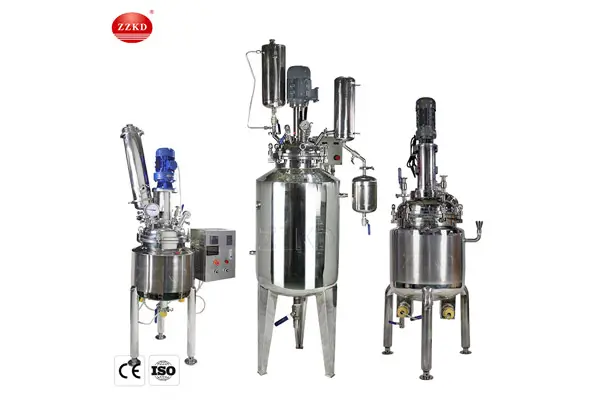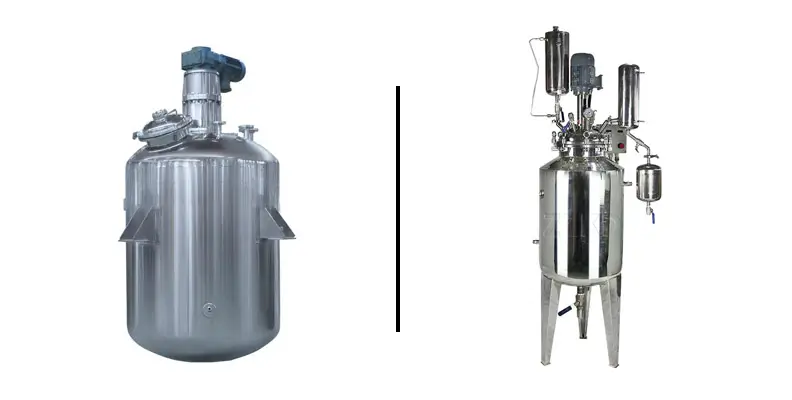What Is a Stainless Steel Reactor?
Struggling to find robust equipment for demanding chemical processes? Need reliable containment for reactions under specific conditions? Finding the right reactor vessel is key.
A stainless steel reactor is a versatile vessel designed for controlling chemical reactions, mixing, or storage, particularly in industrial settings. It's made primarily of stainless steel for durability and corrosion resistance, often featuring components like a tank body, jacket for heating/cooling, and an agitation system.

As a manufacturer with over 16 years focused on lab and industrial equipment like this, I've seen firsthand how crucial the right reactor is. Let's explore what makes stainless steel reactors a popular choice and how they compare to alternatives.
What is the difference between glass lined reactor and stainless steel reactor?
Confused about choosing between glass-lined and stainless steel reactors? Worried about chemical compatibility or pressure limits? Selecting the wrong type can lead to process failures.
The main differences lie in material, resistance, and performance. Glass-lined reactors excel in acid resistance due to their inner glaze, while stainless steel offers better heat transfer, higher pressure tolerance, and greater physical durability. Stainless steel reactors are generally more expensive.

Choosing between a glass-lined reactor (GLR) and a stainless steel reactor (SSR) really depends on your specific process needs. We've helped countless customers navigate this decision. Here's a breakdown of the key factors I usually discuss with them:
Material Construction
A GLR has a steel base but features a layer of glass fused to the interior surface. This glaze provides excellent corrosion resistance, especially against acids. An SSR, as the name suggests, is constructed entirely from stainless steel (like 304 or 316L), known for its mechanical strength and good general corrosion resistance.
Performance Differences
Here's a quick comparison table based on what we typically see:
| Feature | Glass-Lined Reactor (GLR) | Stainless Steel Reactor (SSR) |
| Acid Resistance | Excellent, due to inner glass layer | Good, but less resistant to strong acids than glass |
| Heat Transfer | Moderate, limited by glass layer | Superior, better thermal conductivity |
| Pressure Resistance | Lower limits, glass is brittle | Higher pressure tolerance, metal construction |
| Temperature Limits | Typically below 200°C to protect glaze | Can handle much higher temperatures (e.g., up to 280°C or more with specific heating) |
| Cost | Relatively cheaper for same volume | More expensive than GLR |
| Impact Resistance | Poor, glass can chip or crack easily | Excellent, very durable |
So, if you're dealing with highly corrosive acids but operate at lower pressures and temperatures, a GLR might be suitable. If you need higher pressure/temperature capabilities, better heat transfer, or a more robust vessel, an SSR is usually the way to go. We always advise considering the specific chemicals and operating conditions.
What is the difference between GLR and SSR?
Hearing terms like GLR and SSR and wondering if they are different from what we just discussed? Getting confused by industry acronyms? Let's clarify these common terms.
GLR simply stands for Glass-Lined Reactor, and SSR stands for Stainless Steel Reactor. They are the same types of reactors discussed above, just referred to by their common abbreviations. The differences remain: GLR offers superior acid resistance, while SSR provides better durability, pressure/temperature handling, and heat transfer.
| Feature | Stainless Steel Reactor (SSR) | Glass-Lined Reactor (GLR) | Glass Reactor (GLR) |
|---|---|---|---|
| Primary Material | Stainless Steel | Steel vessel with inner glass/glazed lining | Glass (e.g., Borosilicate) |
| Key Properties | Durable, corrosion-resistant | Combines steel strength with glass lining | Good chemical stability, corrosion-resistant glass |
| Cost Comparison | Often more expensive than glass reactors | Not specified in texts | Can be less expensive than stainless steel |
It's easy to get caught up in abbreviations, but GLR and SSR are just shorthand used frequently in the chemical, pharmaceutical, and related industries. Having worked with clients from pharmaceutical companies to materials science labs for over 16 years, I find clarifying these terms helps ensure everyone is on the same page when specifying equipment. The choice between GLR and SSR fundamentally comes down to application requirements.
When to Prefer GLR (Glass-Lined Reactor)?
Strong Acid Environments: When dealing with highly corrosive acids where even high-grade stainless steel might be challenged, the inert glass lining offers excellent protection. This is common in certain fine chemical or pharmaceutical syntheses.
Purity Concerns: For processes extremely sensitive to metallic ion contamination, the glass lining provides a very inert surface.
Lower Pressure/Temperature Needs: If the process operates well below the pressure and temperature limits of glass lining (typically < 200°C).
Cost Sensitivity: GLRs are often less expensive upfront compared to similarly sized SSRs.
When to Prefer SSR (Stainless Steel Reactor)?
High Pressure/Temperature Operations: When reactions require pressures significantly above atmospheric or temperatures exceeding the limits of glass linings. Many organic syntheses or polymerizations fall here.
Better Heat Transfer Needed: Processes requiring rapid heating or cooling benefit from stainless steel's higher thermal conductivity.
Physical Robustness Required: In environments where accidental impacts are a risk, or for applications like pilot plants or full production where durability is paramount, the toughness of stainless steel is a major advantage.
Alkaline or Neutral Conditions: Where extreme acid resistance isn't the primary concern, SSRs offer excellent performance.
Bioprocessing (Bioreactors): Stainless steel is widely used for bioreactors due to its cleanability, sterilizability, and durability.
Essentially, think of GLR for specialized acid resistance at moderate conditions, and SSR for broader applications demanding higher performance limits and physical strength. As an integrated factory and exporter, we manufacture both types and can help guide you based on your specific process parameters.
What are the advantages of stainless steel bioreactors?
Running biotech or fermentation processes? Need equipment that is sterile, durable, and efficient for cell culture or bioproduction? Stainless steel offers significant benefits here.
Stainless steel bioreactors offer excellent durability, corrosion resistance, and superior cleanability/sterilizability, crucial for sensitive biotech applications. They also provide good thermal conductivity for temperature control, versatility in design, and are highly reliable for long-term use.

In my experience supplying equipment to biotech and life science companies, stainless steel is often the material of choice for bioreactors and fermenters, moving beyond lab-scale glass vessels. There are solid reasons for this preference:
Key Benefits for Bioprocessing:
Durability & Longevity: Stainless steel withstands the physical demands of agitation, pressure, and repeated use much better than glass. This means a longer service life and lower risk of catastrophic failure, leading to better long-term economic efficiency.
Cleanability & Sterilization: The smooth, non-porous surface of electropolished stainless steel is relatively easy to clean (Clean-in-Place, CIP) and can withstand high-temperature steam sterilization (Sterilize-in-Place, SIP) repeatedly without degradation. This is absolutely critical for maintaining aseptic conditions in cell culture or fermentation.
Corrosion Resistance: High-grade stainless steel (like 316L) resists corrosion from media components and cleaning agents, ensuring process integrity and preventing leaching of metallic ions that could harm sensitive cell lines.
Thermal Performance: Good thermal conductivity allows for precise temperature control via jackets or internal coils, essential for optimal biological growth or reaction rates.
Design Flexibility & Scalability: Stainless steel allows for custom designs with various ports, sensors, agitation systems, and vessel geometries. It's also the standard for scaling up from benchtop units to pilot and production-scale bioreactors.
Pressure Handling: Can safely handle the pressures sometimes generated during fermentation or required for certain bioprocesses.
While initial cost might be higher than some alternatives, the reliability, cleanability, and longevity make stainless steel bioreactors a standard in the industry. They ensure process consistency and meet the stringent hygiene requirements of pharmaceutical and biotech manufacturing. We've provided countless stainless steel reactor solutions for these exact applications globally.
How thick is a stainless steel reactor?
Planning to purchase a stainless steel reactor? Wondering about the wall thickness and what determines it? This is a common question related to safety and performance.
The thickness of a stainless steel reactor isn't a single standard value; it varies significantly based on design pressure, operating temperature, reactor diameter (volume), material grade, and applicable design codes (like ASME). Thickness is calculated to ensure safety and structural integrity under operational stress.

Customers often ask about wall thickness, and it's a critical design parameter we calculate carefully for every reactor we build. There's no one-size-fits-all answer because several factors interact to determine the required thickness:
Factors Influencing Wall Thickness:
Design Pressure: This is perhaps the most significant factor. The higher the internal pressure the reactor must contain (including a safety margin), the thicker the walls need to be to prevent rupture. We design based on the maximum expected operating pressure (MAWP).
Reactor Diameter/Volume: For a given pressure, a larger diameter vessel experiences greater stress on its walls (hoop stress). Therefore, larger reactors generally require thicker walls than smaller ones rated for the same pressure.
Operating Temperature: Temperature affects the strength of stainless steel. At higher temperatures, the allowable stress for the material decreases, which may necessitate thicker walls to compensate and maintain safety factors.
Material Grade: Different grades of stainless steel (e.g., 304 vs. 316L) have different strength properties (allowable stress values). A stronger grade might allow for slightly thinner walls under the same conditions compared to a weaker grade.
Corrosion Allowance: In some cases, extra thickness might be added as a corrosion allowance, anticipating gradual material loss over the reactor's lifespan, especially if processing moderately corrosive substances.
Design Codes and Standards: We design and manufacture reactors according to recognized pressure vessel codes (like ASME Boiler and Pressure Vessel Code or relevant international standards). These codes provide formulas and rules for calculating minimum required thickness based on the factors above, ensuring safety and regulatory compliance.
As a manufacturer, we take these calculations very seriously. When a customer provides their process requirements (pressure, temperature, volume, contents), our engineers use these factors and relevant codes to determine the appropriate and safe wall thickness for their specific stainless steel reactor. It's part of ensuring the equipment is not just functional but also robust and safe for its intended use.
Conclusion
Stainless steel reactors are durable, versatile vessels crucial for many industries. Understanding their advantages, differences from GLR, and design factors like thickness helps select the right equipment for reliable processing.
